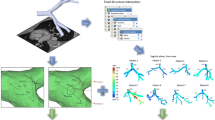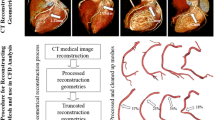Abstract
Purpose
Coronary artery geometry can have a significant impact in the hemodynamic behavior of coronary blood flow, influencing atherosclerotic plaque formation. The present work focuses on, through a statistical study, the connection between several geometric parameters of the right coronary artery—ostium cross-sectional area, angles between the common trunk and the side-branches, tortuosity, curvature and cross-sectional area in each side-branch—and their influence on hemodynamic descriptors. Parameters such as low wall shear stress and local disturbed flow, which are associated with atherosclerosis formation, were analysed.
Methods
Computed tomography images of ten healthy individuals were selected to reconstruct in vivo three-dimensional models of right coronary arteries. Blood flow was simulated through a compliant model with realistic boundary conditions. Calculated hemodynamic descriptors values were correlated with the geometric parameters using the Pearson correlation coefficient (r) and the p value.
Results
The strongest correlations were found in the middle and distal segments of the right coronary artery. A decrease in the ostium area promotes a decrease in the WSS magnitude from the proximal to the distal segment (r = 0.82). Very strong correlations (r > 0.90) were achieved between geometric parameters (cross-sectional area, angle, tortuosity) of the right-ventricular branch and the wall shear stress magnitude in the middle and distal segments.
Conclusions
Low values of tortuosity, smaller cross-sectional area and higher angle of the right-ventricular branch leads to a hemodynamic behavior more propitious to atherosclerosis formation, within the study cases. The right-ventricular branch seems to have the highest influence in the hemodynamic behavior of the right coronary artery.




Similar content being viewed by others
References
Ansys® Academic Research 15.0. ANSYS Fluent Tutorial Guide., 2013.
Bentzon, J. F., F. Otsuka, R. Virmani, and E. Falk. Mechanisms of plaque formation and rupture. Circ. Res. 114:1852–1866, 2014.
Chaichana, T., Z. Sun, and J. Jewkes. Computational fluid dynamics analysis of the effect of plaques in the left coronary artery. Comput. Math. Methods Med. 2012:504367, 2012.
Chu, M., C. von Birgelen, Y. Li, J. Westra, J. Yang, N. R. Holm, J. H. C. Reiber, W. Wijns, and S. Tu. Quantification of disturbed coronary flow by disturbed vorticity index and relation with fractional flow reserve. Atherosclerosis 273:136–144, 2018.
Dahiru, T. P-value, a true test of statistical significance? A cautionary note. Ann. Ibadan Postgrad. Med. 6:21–26, 2011.
Evans, J. D. Straightforward Statistics for the Behavioral Science. Boston: Brooks/Cole, 1995.
Feher, J. Vascular Function: Hemodynamics BT—Quantitative Human Physiology (2nd ed.). Boston: Academic Press, pp. 568–577, 2012. https://doi.org/10.1016/B978-0-12-800883-6.00054-9.
Gallo, D., G. Isu, D. Massai, F. Pennella, M. A. Deriu, R. Ponzini, C. Bignardi, A. Audenino, G. Rizzo, and U. Morbiducci. A survey of quantitative descriptors of arterial flows BT. In: Visualization and Simulation of Complex Flows in Biomedical Engineering, edited by R. Lima, Y. Imai, T. Ishikawa, and M. S. N. Oliveira. Dordrecht: Springer, 2014, pp. 1–24.
Gao, H., Q. Long, M. Graves, J. H. Gillard, and Z. Y. Li. Carotid arterial plaque stress analysis using fluid-structure interactive simulation based on in vivo magnetic resonance images of four patients. J. Biomech. 42:1416–1423, 2009.
Giannoglou, G. D., A. P. Antoniadis, Y. S. Chatzizisis, and G. E. Louridas. Difference in the topography of atherosclerosis in the left versus right coronary artery in patients referred for coronary angiography. BMC Cardiovasc. Disord. 10:2–7, 2010.
Giannopoulos, A. A., Y. S. Chatzizisis, P. Maurovich-Horvat, A. P. Antoniadis, U. Hoffmann, M. L. Steigner, F. J. Rybicki, and D. Mitsouras. Quantifying the effect of side branches in endothelial shear stress estimates. Atherosclerosis 251:213–218, 2016.
Guerciotti, B., C. Vergara, S. Ippolito, A. Quarteroni, C. Antona, and R. Scrofani. A computational fluid–structure interaction analysis of coronary Y-grafts. Med. Eng. Phys. 47:117–127, 2017.
He, X., X. He, D. N. Ku, and D. N. Ku. Pulsatile flow in the human left coronary artery bifurcation: average conditions. J. Biomech. Eng. 118:74–82, 1996.
Johnston, B. M., P. R. Johnston, S. Corney, and D. Kilpatrick. Non-newtonian blood flow in human right coronary arteries: steady state simulations. J. Biomech. 37:709–720, 2004.
Johnston, B. M., P. R. Johnston, S. Corney, and D. Kilpatrick. Non-newtonian blood flow in human right coronary arteries: transient simulations. J. Biomech. 39:1116–1128, 2006.
Kaazempur-Mofrad, M. R., and C. R. Ethier. Mass transport in an anatomically realistic human right coronary artery. Ann. Biomed. Eng. 29:121–127, 2001.
Karimi, A., M. Navidbakhsh, S. Faghihi, A. Shojaei, and K. Hassani. A finite element investigation on plaque vulnerability in realistic healthy and atherosclerotic human coronary arteries. Proc. Inst. Mech. Eng. Part H J. Eng. Med. 227:148–161, 2012.
Karimi, A., M. Navidbakhsh, A. Shojaei, K. Hassani, and S. Faghihi. Study of plaque vulnerability in coronary artery using Mooney-Rivlin model: a combination of finite element and experimental method. Biomed. Eng. Appl. Basis Commun. 26:1450013, 2014.
Kirpalani, A., H. Park, J. Butany, K. W. Johnston, and M. Ojha. Velocity and wall shear stress patterns in the human right coronary artery. J. Biomech. Eng. Asme 121:370–375, 1999.
Knight, J., U. Olgac, S. C. Saur, D. Poulikakos, W. Marshall, P. C. Cattin, H. Alkadhi, and V. Kurtcuoglu. Choosing the optimal wall shear parameter for the prediction of plaque location—A patient-specific computational study in human right coronary arteries. Atherosclerosis 211:445–450, 2010.
Lee, S.-W., L. Antiga, and D. A. Steinman. Correlations among indicators of disturbed flow at the normal carotid bifurcation. J. Biomech. Eng. 131:061013, 2009.
Liu, G., J. Wu, D. N. Ghista, W. Huang, and K. K. L. Wong. Hemodynamic characterization of transient blood flow in right coronary arteries with varying curvature and side-branch bifurcation angles. Comput. Biol. Med. 64:117–126, 2015.
Malek, A. M., S. L. Alper, and S. Izumo. Hemodynamic shear stress and its role in atherosclerosis. JAMA 282:2035–2042, 1999.
Malvè, M., A. M. Gharib, S. K. Yazdani, G. Finet, M. A. Martínez, R. Pettigrew, and J. Ohayon. Tortuosity of coronary bifurcation as a potential local risk factor for atherosclerosis: CFD steady state study based on in vivo dynamic CT measurements. Ann. Biomed. Eng. 43:82–93, 2014.
Myers, J. G., J. A. Moore, M. Ojha, K. W. Johnston, and C. R. Ethier. Factors influencing blood flow patterns in the human right coronary artery. Ann. Biomed. Eng. 29:109–120, 2001.
Pinho, N., M. Bento, L. C. Sousa, S. Pinto, C. F. Castro, C. C. António, and E. Azevedo. Patient-Specific Study of a Stenosed Carotid Artery Bifurcation Using Fluid–Structure Interactive Simulation BT—VipIMAGE 2017: Proceedings of the VI ECCOMAS Thematic Conference on Computational Vision and Medical Image Processing Porto, Portugal, Octob. edited by J. M. R. S. Tavares, and R. M. Natal Jorge. Cham: Springer International Publishing, 2018, pp. 495–503. https://doi.org/10.1007/978-3-319-68195-5_54.
Pinho, N., C. F. Castro, C. C. António, N. Bettencourt, L. C. Sousa, and S. I. S. Pinto. Correlation between geometric parameters of the left coronary artery and hemodynamic descriptors of atherosclerosis: FSI and statistical study. Med. Biol. Eng. Comput. 2018. https://doi.org/10.1007/s11517-018-1904-2.
Pinto, S., and J. B. L. M. Campos. Numerical study of wall shear stress-based descriptors in the human left coronary artery. Comput. Methods Biomech. Biomed. Eng. 19:1443–1455, 2016.
Pinto, S. I. S., J. B. L. M. Campos, E. Azevedo, C. F. Castro, and L. C. Sousa. Numerical study on the hemodynamics of patient-specific carotid bifurcation using a new mesh approach. Int. J. Numer. Method. Biomed. Eng. 34:e2972, 2018.
Siogkas, P. K., M. I. Papafaklis, A. I. Sakellarios, K. A. Stefanou, C. V. Bourantas, L. S. Athanasiou, T. P. Exarchos, K. K. Naka, L. K. Michalis, O. Parodi, and D. I. Fotiadis. Patient-specific simulation of coronary artery pressure measurements: An in vivo three-dimensional validation study in humans. Biomed Res. Int. 2015, 2015.
Soulis, J. V., and D. K. Fytanidis. Oscillating shear index, wall shear stress and low density lipoprotein accumulation in human RCAs. Acad. Sci. USA 32:867–877, 2010.
Sousa, L. C., C. F. Castro, C. C. António, A. M. F. Santos, R. M. dos Santos, P. M. A. C. Castro, E. Azevedo, and J. M. R. S. Tavares. Toward hemodynamic diagnosis of carotid artery stenosis based on ultrasound image data and computational modeling. Med. Biol. Eng. Comput. 52:971–983, 2014.
Sousa, L. C., C. F. Castro, C. C. António, J. M. R. S. Tavares, A. M. F. Santos, R. M. Santos, P. Castro, and E. Azevedo. Simulated hemodynamics in human carotid bifurcation based on Doppler ultrasound data. Int. J. Clin. Neurosci. Ment. Health 1(1–7):15, 2014.
Torii, R., J. Keegan, N. B. Wood, A. W. Dowsey, A. D. Hughes, G. Z. Yang, D. N. Firmin, S. A. M. Thom, and X. Y. Xu. MR image-based geometric and hemodynamic investigation of the right coronary artery with dynamic vessel motion. Ann. Biomed. Eng. 38:2606–2620, 2010.
Torii, R., N. B. Wood, N. Hadjiloizou, A. W. Dowsey, A. R. Wright, A. D. Hughes, J. Davies, D. P. Francis, J. Mayet, G.-Z. Yang, S. A. M. Thom, and X. Y. Xu. Fluid–structure interaction analysis of a patient-specific right coronary artery with physiological velocity and pressure waveforms. Commun. Numer. Methods Eng. 25:565–580, 2009.
Wellnhofer, E., J. Osman, U. Kertzscher, K. Affeld, E. Fleck, and L. Goubergrits. Flow simulation studies in coronary arteries-impact of side-branches. Atherosclerosis 213:475–481, 2010.
WHO. The Atlas of Heart Disease and Stroke. Geneva: WHO, 2010.
Womersley, J. R. Method for the calculation of velocity, rate of flow and viscous drag in arteries when the pressure gradient is known. J. Physiol. 127:553–563, 1955.
Zakaria, H., A. M. Robertson, and C. W. Kerber. A parametric model for studies of flow in arterial bifurcations. Ann. Biomed. Eng. 36:1515–1530, 2008.
Zeng, D., E. Boutsianis, M. Ammann, K. Boomsma, S. Wildermuth, and D. Poulikakos. A study on the compliance of a right coronary artery and its impact on wall shear stress. J. Biomech. Eng. 130:041014, 2008.
Zeng, D., Z. Ding, M. H. Friedman, and C. Ross Ethier. Effects of cardiac motion on right coronary artery hemodynamics. Ann. Biomed. Eng. 31:420–429, 2003.
Zhang, Q., B. Gao, and Y. Chang. Effect of different rotational directions of BJUT-II VAD on aortic swirling flow characteristics: a primary computational fluid dynamics study. Med. Sci. Monit. 22:2576–2588, 2016.
Zhu, H., and M. H. Friedman. Relationship between the dynamic geometry and wall thickness of a human coronary artery. Arterioscler. Thromb. Vasc. Biol. 23:2260–2265, 2003.
Acknowledgments
Authors gratefully acknowledge the financial support of the Foundation for Science and Technology (FCT), Portugal, the Engineering Faculty of University of Porto (FEUP), the Institute of Science and Innovation in Mechanical and Industrial Engineering (LAETA-INEGI), the Cardiovascular R&D Unit of the Medicine Faculty of University of Porto (FMUP) and the Cardiology Department of Gaia/Espinho Hospital Centre.
Conflict of interest
Authors declare that they have not any actual or potential conflict of interest.
Ethical Approval
All procedures followed were in accordance with the ethical standards of the responsible committee on human experimentation (institutional and national) and with the Helsinki Declaration of 1975, as revised in 2000 (5).
Informed Consent
Informed consent was obtained from all patients for being included in the study.
Author information
Authors and Affiliations
Corresponding author
Additional information
Associate Editor Sarah Vigmostad and Ajit P. Yoganathan oversaw the review of this article.
Publisher's Note
Springer Nature remains neutral with regard to jurisdictional claims in published maps and institutional affiliations.
Electronic supplementary material
Below is the link to the electronic supplementary material.
Rights and permissions
About this article
Cite this article
Pinho, N., Sousa, L.C., Castro, C.F. et al. The Impact of the Right Coronary Artery Geometric Parameters on Hemodynamic Performance. Cardiovasc Eng Tech 10, 257–270 (2019). https://doi.org/10.1007/s13239-019-00403-8
Received:
Accepted:
Published:
Issue Date:
DOI: https://doi.org/10.1007/s13239-019-00403-8




